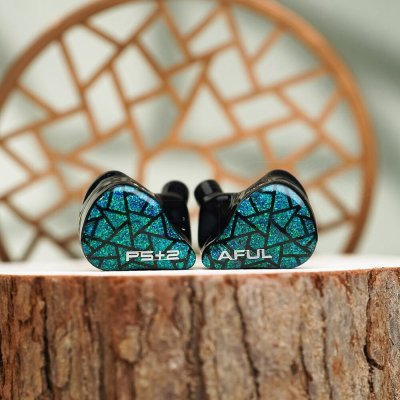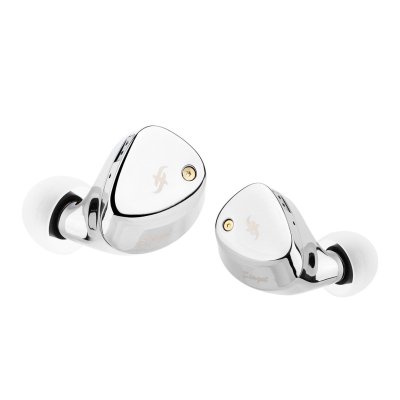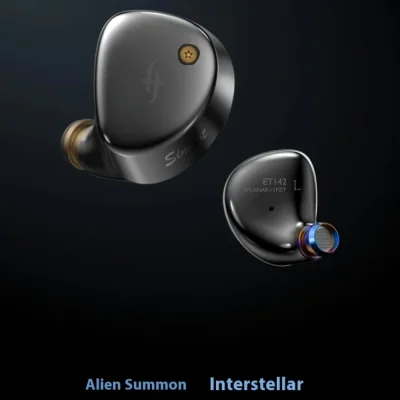Aful Performer 5+2 and Simgot ET142 use 2DD+4BA+1Planar and 1Planar+1BC driver setups respectively. Aful Performer 5+2 costs $229 while Simgot ET142 costs $220. Aful Performer 5+2 is $9 more expensive. Aful Performer 5+2 holds a slight 0.1-point edge in reviewer scores (7.6 vs 7.5). Simgot ET142 carries a user score of 7.3. Aful Performer 5+2 has slightly better bass with a 0.4-point edge, Simgot ET142 has slightly better treble with a 0.4-point edge and Simgot ET142 has slightly better details with a 0.4-point edge.
Insights
| Metric | Aful Performer 5+2 | Simgot ET142 |
|---|---|---|
| Bass | 7.9 | 7.4 |
| Mids | 7.7 | 7.8 |
| Treble | 7.2 | 7.6 |
| Details | 7.2 | 7.6 |
| Soundstage | 7.2 | 7.5 |
| Imaging | 7.2 | 7.5 |
| Dynamics | 7.3 | 7.5 |
| Tonality | 7.6 | 7.7 |
| Technicalities | 7.5 | 7.8 |
Aful Performer 5+2 Aggregated Review Score
Average Reviewer Scores
Average Reviewer Score:
7.6Strongly Favorable
Simgot ET142 Aggregated Review Score
Average Reviewer Scores
Average Reviewer Score:
7.5Strongly Favorable
Reviews Comparison
Aful Performer 5+2 reviewed by Z-Reviews
Youtube Video Summary
Naming drama aside (P5+2? just call it Performer 7), this Aful packs a quirky driver party: 2DD for low end, 4 BA split across mids/treble, plus a tiny micro-planar for the highest sparkle, all marshaled by Aful’s neat miniature crossover. The shells are lightweight, comfy and prettier than they need to be; the cable feels “don’t bother swapping” nice, with 3.5 or 4.4 options. The box is loaded with silicone tips but no foam—a miss, because the right seal changes everything. Price target sits around $250, which sets expectations high but not ridiculous.
Stock silicone yields a surgical, respectful tuning with bass that skews neutral and controlled. Swap to well-sealing foam or hybrids and feed a juicy source (warm Class A or tubes) and the set wakes up—stage snaps into a cohesive scene right in front, imaging gets laser-etched, and that micro-planar adds a pinch-of-salt treble spice without turning harsh. It’s an up-close presentation—sometimes almost claustrophobically detailed—in the best way: think “men with trumpets in the head,” precise placement, and excellent extension up top. Not as rowdy as the Explorers; more like a surgeon in a Hawaiian shirt—technical, but with a wink.
Practical upside: the clarity and positioning make this great for gaming and even viable for mixing/mastering checks; just don’t crank it into pain territory. Bass stays tight and responsive, treble sails high, and coherence holds. Tip and source matter a lot: with foam + warm power, it sings; with plain silicone, it’s merely polite. Final tally: a confident 8.5/10—doing a lot right at its price, dinged half a point for making everyone do math on the name.
Z-Reviews Youtube Channel
Buy Aful Performer 5+2 on HiFiGO
Ad
Price: $213
Buy Aful Performer 5+2 on HiFiGO
Simgot ET142 reviewed by Z-Reviews
Youtube Video Summary
SIMGOT ET142 comes across as a sleek, chrome-heavy hybrid with a planar + PZT setup, dressed in CNC’d stainless shells and a surprisingly thick premium cable, plus a magnetic case and swappable 4.4/3.5 plug. Two tuning nozzles are included; differences are subtle, but the gold nozzles give a warmer, more relaxed balance versus the blued “airier” set. At a listed ~$220, the build and accessories feel upscale, though that cable is borderline overkill for an IEM.
On power, the ET142’s 14 Ω load behaves better with a more linear solid-state source (e.g., JDS Labs Element) than with tubes; an impedance adapter can tame noise. The tuning reads smooth, non-aggressive, with bass present but not the star; sub-bass “slam” isn’t the focus, yet vocals and staging are clean and pleasing. Treble with the gold nozzles stays polite, while the blued set adds some sparkle without turning harsh.
The special sauce is the imaging: sound feels “inside” and slightly behind the head, creating a quirky but engaging sense of placement that should be excellent for gaming. Overall it fits neatly among planar hybrids at this price—refined, smooth, and easy to enjoy rather than a fireworks show—earning a straightforward recommendation, especially for SIMGOT fans who value comfort, build, and that distinctive spatial presentation over brute-force bass.
Z-Reviews Youtube Channel
Buy Simgot ET142 on Linsoul
Ad
Price: $219.99
Buy Simgot ET142 on Linsoul
Aful Performer 5+2 reviewed by Audio Amigo
Youtube Video Summary
The AFUL Performer 5+2 (Performer 7 / P7) takes the P5 recipe and adds a second 6 mm dynamic for the lows and a micro-planar for the highs, nudging MSRP to $240. Unboxing mirrors the P5: nine pairs of tips and a decent case, but the accessories feel bare-bones at this price—no foam tips and a non-modular cable, even though the included 8-wire is supple and well-behaved. Build is classic AFUL: 3D-printed resin, blended nozzle (no mesh or lip—watch tip retention), single rear vent, and striking blue-green mosaic shells inspired by Suzhou gardens—cool-wall approved with four compliments to one “meh.” Fit is semi-custom and a touch chunkier than P5; comfortable for most, a conditional pass for small ears. Note a sporadic batch quirk: some units have over-tight 2-pin sockets; exchanges fixed it for affected buyers.
Tuning sits in warm-leaning neutral territory. The dual dynamics deliver punchy, textured bass that rumbles without bloating; guitars and drums carry convincing weight. Mids are the star—rich, full-bodied, vocal-forward without shout, with clean separation and natural tone. Treble from the micro-planar is smooth yet energetic: cymbals and vocal harmonics sparkle, special effects have bite and body, and only treble-sensitives may find hot mixes a bit lively. Technicalities impress for the money—detail retrieval and nuance feel a class up—while stage and imaging are solid rather than showy.
Against peers: the Tangzu x HBB budget pick mirrors the overall tonality but P7 offers higher resolution and more treble finesse; the planar “Heyday” alternative is brighter/faster with leaner bass; versus Performer 5, P7 brings tighter low-end, smoother treble, and better extremes detail; the Fresh-collab competitor pushes vocals further forward with bigger stage but leaner lower mids. Verdict: a versatile all-rounder that suits broad libraries and even content creation thanks to its balanced tonality and detail. Not for bassheads, trebleheads, or strict Harman-lean seekers, and the accessory pack/cable quirk holds it back from a slam-dunk. For roughly $240, though, it’s a brilliant, resolving upgrade in the AFUL line.
Audio Amigo Youtube Channel
Simgot ET142 reviewed by Audio Amigo
Youtube Video Summary
The Simgot ET142 is a $220 planar–piezo hybrid that arrives like a mini system: full-metal shells, the chunky but well-behaved LC7 modular cable (3.5/4.4 included), a sturdy magnetic case, and four tuning nozzles (titanium stock, gold, short black foam, short red foam). Build is solid and venting prevents pressure issues; finish is a fingerprint magnet and the shell+cable combo is heavy, comfortable for average ears but failing the “tiny ears” test in stock form. Accessory spread is excellent at the price, with multiple tip sets and spare O-rings/foams rounding out a thoughtful package.
Sonically, this is textbook planar bass: clean sub-bass rumble with punchy, textured mid-bass that doesn’t bleed. The midrange stays clear and unmasked, presenting busy mixes with ease, while vocal presence shifts with nozzle choice (short nozzles push fundamentals slightly forward). Treble is where the nozzles matter most: short red = relaxed and smooth; short black = balanced sparkle; titanium/gold = vivid, edging toward “hot” for treble-sensitive listeners. Technical chops impress—crisp microdetail from the PZT without harshness, precise imaging, strong separation, and a notably 3D soundstage. It’s also very easy to drive, playing happily from modest sources.
Think of ET142 as a three-in-one planar: titanium delivers a bright, energetic V-shape (S12/“classic planar” territory), short black dials it to a balanced, less aggressive profile (S12 Pro/2024 vibe), and short red shifts into the modern warm planar lane (akin to S15/S08). Compared with other nozzle-swap sets (e.g., Timeless 2), ET142 offers a wider tuning range up top, trading fine micro-timbre tweaks for genuinely distinct signatures. Caveats: none of the nozzles are truly neutral and the low end stays boosted, so lean-bass seekers should look elsewhere; the weight may be a deal-breaker for small ears. For anyone wanting a versatile planar that can swing from sparkly and fun to warm and relaxing with a quick nozzle swap, this earns a confident “you should buy this” recommendation on value and flexibility alone.
Audio Amigo Youtube Channel
Aful Performer 5+2 reviewed by Jays Audio
Youtube Video Summary
Performer 7 lands with a neutral-balanced, laid-back tuning and good treble reach. The presentation is clean and generally safe, though there’s a touch of sizzly “planar-ish” timbre up top. Technicals are solid for ~$200—slightly behind sets like Quintet and Super Mix 4, about on par with Nova. Bass from the dual 6 mm DDs is tight, controlled, and free of bleed, but lacks the slam and rumble of competitors using larger drivers; mids are well separated with decent layering.
The weak spot is vocal extension: a push around 1.5 kHz tries to bring them forward, but a dip through 3–6 kHz keeps them from opening up. Tamer upper-mids help avoid fatigue for rock/metal, yet the modest low-end impact leaves drums and basslines feeling uneventful. It’s a mid-volume set that doesn’t scale well—turning it up accentuates the 1.5 kHz emphasis and treble sizzle. Treble isn’t peaky, just a bit glassy at times; for K-pop the smoother mids can work if less extended vocals are acceptable.
As a value play, there are stronger options: Nova, Chopan, and Super Mix 4 offer better bang-for-buck; for a similar clean/neutral target, Tanchjim Origin sounds more natural with better bass texture and vocal reach, and DynaQuattro adds sub-bass and fuller vocals—none with the planar-ish timbre. Even AFUL’s own P5 is cheaper and more fun, while the Explorer undercuts the price and scales impressively. In today’s crowded market, P7 is a competent all-rounder but not distinctive enough to stand out.
Jays Audio Youtube Channel
Simgot ET142 reviewed by Jays Audio
Youtube Video Summary
SIMGOT’s ET142 pairs a planar driver with a PZT, delivering a bright-leaning, lively all-rounder that feels like a more mature, slightly more detailed take on the original S12 tonality. Treble is the surprise: it carries bite and air without the usual planar “sizzle”, landing closer to a well-implemented PZT sheen. Micro-nuance on cymbal work is improved, vocals are open, and technical performance is among the best heard from planars in this bracket. The 2 kHz region can read a touch shy, while overall treble sits above Harman, so expect sparkle and energy rather than warmth.
Volume and fit matter. At mid levels (~60–65 dB) the ET142 sounds engaging and airy; push past ~70–75 dB and the upper energy can turn fatiguing, with forward vocals and sharper highs on busy tracks. Tip choice is critical: treble-boosting tips can be too much, whereas wide-bore, smoother tips (e.g., “Senai Wide”) keep the top end in check. Both included nozzles measure and sound essentially the same—an opportunity missed for a second, tamer tuning. Genre-wise, rock, indie and slower pop benefit from the speed and air; dense electronic can edge bright, while K-/J-pop stays bouncy at moderate volume.
Bass is quick, punchy and clean with tight decay and excellent separation—don’t expect DD-level rumble or lingering reverb, but do expect balance and definition. Versus safer, more relaxed tunings (S8/S15/S12 2024), the ET142 is the more exciting pick; against neutral all-rounders (e.g., “Pilgrim”), it trades smoothness for air and sparkle; compared to sets like “Dusk,” it’s livelier with less treble fizzle but a more forward top end. At around $200, build is excellent (metal shells, braided cable) and the value strong—competing with some $300–$400 options. In short: choose ET142 for a bright, technical, energetic listen; skip it if a laid-back or dark tilt is the goal.
Jays Audio Youtube Channel
Aful Performer 5+2 reviewed by Paul Wasabii
Youtube Video Summary
The AFUL Performer 5+2 takes the familiar hybrid recipe of dual 6 mm dynamics, four balanced armatures and a micro planar and spins it into a distinctly vocal focused presentation. Vocals are pushed very close, giving an intimate, close talker character that will immediately stand out from more typical U shaped hybrids. This forwardness comes at a cost, as the overall soundstage feels flatter and smaller than many competitors, with the midrange taking center stage at the expense of a more spacious image.
The dual 6 mm drivers deliver a sub bass tilted low end that has respectable rumble and enough level to support genres that appreciate extra weight, while avoiding obvious boom or bloat. Impact and tactility are on the softer side, and combined with the elevated midrange and treble, bass presence tends to sit very close to the vocals rather than carving out its own layer. This crowding effect, together with the warm, smoothed textures, means layering and separation never really open up, giving the Performer 5+2 a more compact, blended presentation than many modern tribrids.
The treble region is where the tuning feels least controlled, with peaks across the upper mids, presence and air bands that can bring out snare hits and sibilants and push the micro planar into an overdriven, slightly unnatural timbre. The intended advantage of the micro planar is largely lost in this boost, keeping overall technicalities such as detail retrieval, imaging precision and stage depth firmly in the moderate camp rather than a clear step up from AFULs other models. As a result, Performer 5+2 emerges as a niche choice for listeners who strongly prioritize upfront vocals and do not mind a smaller, more intense stage, while those looking for a more balanced, spacious and natural presentation will likely find better options elsewhere.
Paul Wasabii Youtube Channel
Simgot ET142 reviewed by Paul Wasabii
Youtube Video Summary
SIMGOT ET142 pairs a polished CNC metal shell with a comfortable ergonomic fit and the LC7 modular cable including 3.5 mm and 4.4 mm plugs plus a case. Four interchangeable nozzles are provided, with revised geometry in production rather than just foam stuffing, and the foam can be added or removed for fine-tuning. Build and accessories feel genuinely premium for the segment.
The original gold/blue nozzles target a brighter, analytical upper range; the new black sits in the middle with a smoother treble line, and red is the most restrictive and warmest. With black, ET142 tracks close to Letshuoer S12 2024 in balance but remains more relaxed up top with slightly less resolve; with red, the tonality leans toward a clean, dynamic-driver style that edges out Timeless 2's Gold Leaf for ease of listening. Swapping foam in or out yields small but useful shifts without breaking the core signature.
As a package, this set prioritizes tuning flexibility and ease of listening over chasing maximum air and extension. S12 2024 stays the single-planar reference for sheer end-to-end resolution, but ET142 answers with a best-in-class shell and cable and friendlier options for treble-sensitive ears. For those wanting planar technicalities with a smoother top end, the black and red nozzles form a compelling, configurable choice.
Paul Wasabii Youtube Channel
Aful Performer 5+2 (more reviews)
Aful Performer 5+2 reviewed by Jaytiss
Youtube Video Summary
Aful Performer 5+2 lands as a hybrid of the beloved Performer 5 and the punchier Explorer. The unboxing is the familiar P5 affair—same case, same style of tips—nothing flashy, but solid. The shell mirrors the P5 in size with a comfy little stabilizing wing that locks in well. No metal nozzle or front filter here, yet tip retention is secure and hassle-free. The flat 2-pin socket is straightforward, and the stock cable feels thick and supple with a reliable chin slider and handy red/blue channel markers. Overall: understated build, great ergonomics, daily-driver ready.
Sonically, this one aims neutral with a very distinct top end—clean, dynamic, incisive. Think switching from black-and-white to color; cymbals and overtones pop with a slightly crunchy/pristine edge that energizes detail without turning harsh on good recordings. Bass isn’t about sheer quantity; it’s about slam and dynamics—quick on the draw, well-controlled, and satisfying when called upon. Vocals sit a notch forward, microdetail is strong, and the overall presentation is coherent, clear, and technical with convincing stage, resolution, and imaging. Not a treble-shy or bass-bombed tuning—more a refined all-rounder for those who want clarity and bite.
Versus the original P5, the 5+2 fixes the missing “air” and soft edges, trading them for crisper transients and better extension. Compared with Explorer (a value champ), the 5+2 brings superior upper-treble reach, detail, and vocal focus. Against Performer 8 and Cantor, it feels more visceral—the P8 is smoother and more relaxed, while Cantor pulls finer microdetail but with less bass slam. Sets like Dino Quattro or J’s Estrella bring bigger fun or treble theatrics, yet the 5+2’s balance and everyday versatility win more often. Net take: a neutral-leaning, highly technical upgrade that stands tall in its bracket—easy to recommend to anyone chasing clarity, speed, and controlled impact over pure warmth or excess bass.
Jaytiss Youtube Channel
Aful Performer 5+2 reviewed by Super* Review
Youtube Video Summary
Aful’s Performer 5+2 upgrades the original hybrid with 2DD + 4BA + 1 micro-planar tweeter and lands around $240–$250. The unboxing is practical: three sets of silicone tips, a pocketable puck case, and a soft, nicely draping cable (available in 4.4 or 3.5), though the braid can look a bit loose and the pre-formed hooks run large. The resin shells shift between blue and green under different light; fit is medium-large, very stable, and comfortable once the right tips are found. Note the narrow nozzle without a retaining lip and partially exposed bores/filters—tip grip is key and a little care prevents ear-gunk ingress.
Tonally this leans mild V-shaped: a clean midrange with a confident bass boost, a touch of lower-treble presence for bite, and well-extended air up top. The result is more incisive and punchy than the original P5, with clearer on/off transients that aid separation and layering. Trade-offs show as a hint of gritty/plasticky treble texture on cymbals and brushes—not harsh, but less natural than ideal—while the bass stays tight and exciting.
Against Aful’s Explorer, this sounds brighter, more spacious, and more technical; Explorer plays warmer/denser with smoother treble but less openness. Versus the pricier Thieaudio Oracle MK3, tuning is broadly similar: Oracle is smoother and deeper with a softer attack, while the Performer 5+2 brings more snap and engagement for less money. As a modern mid-tier hybrid, it absolutely still has a place—energetic, spacious, and well-executed—earning a solid four stars.
Super* Review original ranking
Super* Review Youtube ChannelAful Performer 5+2 reviewed by Audio-In Reviews
Youtube Video Summary
The AFUL Performer 5+2 continues AFUL's streak of strong releases in the mid tier, bringing a tribrid driver setup into the very competitive 200 to 300 dollar range. The shell is well finished, slightly larger than the original Performer 5 but still very comfortable, with careful contouring that avoids hot spots in daily use. Build quality feels solid, the faceplate design is arguably AFUL's best yet, and the soft, easy to manage cable complements the overall aesthetics very nicely.
Sonically the set sits between neutral and mild V-shaped, with a boosted bass and a bit of extra treble energy while the mids stay slightly relaxed. Bass quantity is north of neutral, focused below roughly 200 to 300 hertz with good extension, giving a punchy, dynamic and physical low end that provides a visceral sub bass experience without noticeable bleed into the mids. A touch of extra low mids adds warmth, note weight and richness to male vocals while the midrange remains clean, detailed and natural, without odd peaks or dips. Treble carries some of the delicate character expected from a micro planar driver, with forward lower treble that adds bite and energy, plenty of upper treble extension, shimmer and air, staying engaging without becoming harsh or fatiguing; only a slightly less natural cymbal timbre versus sets like Da Vinci, Dino Quattro and Butterfly 61T stands out as a minor nitpick.
Technical performance is very strong for the price, at least on par with the Butterfly 61T, previously a reference for technicalities around 200 dollars, and the Performer 5+2 may even edge it out in soundstage and imaging, which come across as slightly above average versus other in ear monitors in this range. Within the 200 to 250 dollar bracket it can reasonably be considered one of the best technical performers available, while still offering an engaging, airy and exciting tuning that many listeners could daily drive. Those who prefer a smoother, more relaxed upper mid and treble presentation might still lean toward the Butterfly 61T, but the Performer 5+2 earns a very strong recommendation for anyone wanting a more lively, high performing tribrid that competes confidently among the top options in this segment.
Audio-In Reviews original ranking
Audio-In Reviews Youtube ChannelAful Performer 5+2 reviewed by Kois Archive
Kois Archive Youtube Channel
Aful Performer 5+2 reviewed by Audionotions
Aful Performer 5+2 reviewed by Gizaudio Axel
Gizaudio Axel original ranking
Gizaudio Axel Youtube ChannelAful Performer 5+2 reviewed by Tim Tuned
Aful Performer 5+2 reviewed by Web Search
The AFUL Performer 5+2 (also listed as “Performer 7”) uses a 2DD+4BA+1 micro planar driver array and AFUL’s LC-network crossover plus a 3D-printed acoustic tube system, aiming for clean band splits without smearing. The shell also integrates a high-damping air-pressure balance system, a design AFUL has used across its line. Official listings put MSRP around $229 and outline the same core tech features.
Tonally it trends neutral with a sub-bass lift: bass has solid depth and texture, mids stay relatively linear, and the presence/treble region adds energy without veering into sharpness on most chains. Multiple reviews characterize it as warm-neutral with bass boost or slightly V-shaped depending on perspective, which matches listening notes about a lively but controlled upper end. Sensitivity and load are portable-friendly (≈109 dB, 15 Ω), so it reaches performance without demanding amplification.
Technicalities are competitive for the class: imaging is tidy with good instrument separation, micro-detail retrieval is above average, and soundstage is moderate (more width than depth). Build and comfort are typical resin-shell fare; some users note occasional lower-treble bite depending on tips and recordings, so treble-sensitive listeners may wish to pair accordingly. Overall value is strong at its price, especially if a clean, bass-supported neutral curve is the priority.
Simgot ET142 (more reviews)
Simgot ET142 reviewed by
 Fresh Reviews
Fresh Reviews
Youtube Video Summary
Build & accessories: ET142 arrives with an all-metal chassis, a tidy two-pin cable with interchangeable termination, and swappable nozzles (blue default vs. gold). The blue nozzle proves smoother, as the gold adds extra 2–3 kHz energy that can edge into shout. Ergonomics are compact, vented, and well-finished, though not as feather-light as some resin competitors.
Tuning & technicals: The hybrid architecture (planar plus bone-conduction) projects an expansive, airy stage with clean separation and layering. However, that upper-mid peak can make gunfire and busy mixes feel a bit spicy, leading to a “deer-in-headlights” sensation during chaotic moments. Tonally it’s clear and detailed, but the extra air sometimes pushes nearfield cues slightly forward in the stage instead of delivering immediate urgency.
Gaming performance: Imaging and verticality are solid and footstep cues are intelligible, placing ET142 in a B+ to B range for competitive play. Against a warmer rival with stronger low-end presence, ET142 is less fatiguing than the gold-nozzle setup but still brighter than ideal for Apex/Valorant chaos; the rival’s bass weighting keeps gunfire tamed and localization snappier. Overall, ET142 is good for gaming with strong separation and stage, best for players who value clarity and air over maximum urgency.
Fresh Reviews original ranking
Fresh Reviews Youtube ChannelAful Performer 5+2 Details
Driver Configuration: 2DD+4BA+1Planar
Tuning Type: Neutral with Bass Boost
Brand: AFUL Top AFUL IEMs
Price (Msrp): $229
Support our free service! Buying through our affiliate links costs you nothing extra:
Simgot ET142 Details
Driver Configuration: 1Planar+1BC
Tuning Type: V-Shaped
Brand: Simgot Top Simgot IEMs
Price (Msrp): $220
Support our free service! Buying through our affiliate links costs you nothing extra:
Aful Performer 5+2 User Review Score
Average User Scores
Average User Score: n/a
Based on 0 user reviews
No user reviews yet. Be the first one who writes a review!
Simgot ET142 User Review Score
Average User Scores
Average User Score:
Based on 1 user reviews
7.3Generally Favorable
Aful Performer 5+2 Gaming Score

Gaming Score & Grade
- The gaming score is prioritizing technical capabilities of the IEM (Separation, Layering, Soundstage) and good value.
Gaming Score
7.5Gaming Grade
ASimgot ET142 Gaming Score

Gaming Score & Grade
- The gaming score is prioritizing technical capabilities of the IEM (Separation, Layering, Soundstage) and good value.
Gaming Score
8Gaming Grade
A+Aful Performer 5+2 Scorings
Average Technical & Tuning Grades
Average Tunign Grade
A- Tuning feels well executed, keeping a natural flow across the spectrum. Switching genres feels seamless.
Average Technical Grade
A- Overall technical control is strong, presenting instruments with clarity and sensible staging. Textures are portrayed with satisfying clarity.
Simgot ET142 Scorings
Average Technical & Tuning Grades
Average Tunign Grade
A- Tuning feels well executed, keeping a natural flow across the spectrum. Switching genres feels seamless.
Average Technical Grade
A- The balance of resolution and space feels assured, keeping complex passages coherent. Layering is convincing on most studio mixes.
Aful Performer 5+2 User Reviews
"This is an example review"
Pros
- Example pro 1
- Example pro 2
Cons
- Example con 1
- Example con 2
Share your experience and build your personal ranking list.
You need to be signed in to write your own reviewSimgot ET142 User Reviews
Share your experience and build your personal ranking list.
You need to be signed in to write your own reviewThe Simgot ET142 delivers a smooth and natural sound signature with strong mids but lacks impact in the bass region.
Pros
Clear and detailed mids with good instrument separation; solid build quality and comfortable fit.Cons
Bass can feel a bit light for bassheads; soundstage is average and not very wide.Find your next IEM:
IEM Finder Quiz
newIEM Comparison Tool
newVS






























